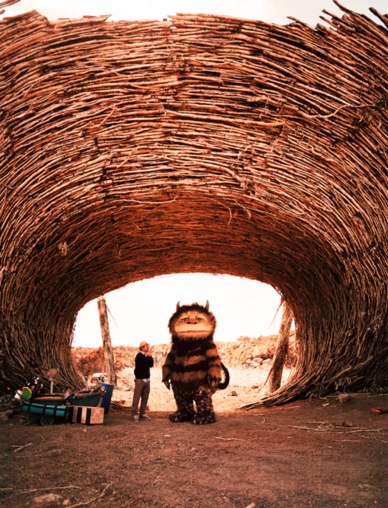
Spike Jonze has long been known for skateboard videos, music videos, Ikea commercials. With his second big screen work, Where the Wild Things Are all of the techniques he's long crafted and worked come together over the course of a story about childhood. The difference in this book to film adaptation is that most films have to cut out sections of the book, revise them to fit into the temporal space of a theater going audience. In this case the reverse is true; Jonze had to figure out how to add a storyline of sorts to the classic childrens' book, a book that many of us writing about it grew up on no doubt. The main ways this film stays afloat is through an indy soundtrack--courtesy of Karen O.--which fills up every non dialogue visual moment by doubling the affect of the image with harmony. But embedded in this non-diagetic sound is the notion that audiences are no longer complacent with the silent spectacle a la carte.

The story line Jonze is able to work over the original text is simple, the mirror image of Max at home in the snow fort imagining friends to play with comes to life; indeed this is the entirety of the book. The gaps that are filled in come from the creatures that Max imagines. As the seven segments of Max's imagination they fulfill the different slices of suburban banality experienced in the films opening, emphasized with the physical action of fort-home smashing at the onset of the island experience. Where initially the Wild things seem to have respective Real people, the course of the film leads us in a different direction and the cast list and voice list keep this association explicitly separate. But what comes to life is the sort of nonsensical portions of childhood, the emotional states running rampant without any consequences or guidance. The structure of the island is the structure of adolescence, but we can also read it as one of our economic situation; unstable present is complicated with perceived and indefinite changes in the future and the uncertainty there in. Following this path gets quite complicated if we consider the chocolate cake-wall street bailout concluding moment, no words just the satisfaction of the senses. Yes, you can run away from your problems and then come back and be rewarded.

On the level of parable we find that the role of Carol, voiced by James Gandolfini, while immediately the alter ego of Max is also a dangerous similarity to that of abusive-stereotypical alcoholic father figure. He looks down to Max in the same way Max looks up to him. Their reciprocal needs for the family unit and their displacement of that dissatisfaction into both the artistic-creative and the fury of destruction as poles reveals the unstable role of both. The difference is that one grows up, the other either sobers or continues to widen the fissures of a failing nuclear family model. And this comes out as the most significant thing the film portrays. That creation and destruction are a dialectic relationship, equally possible in each person. That the rumpus exists in the act of smashing, and that building is always the second half movement of last nights fit of despair. That the new architecture of the collective(Wild Thing City) will be more awe inspiring, environmentally considerate, complicated, and marginally more enjoyable, than the individualized nest homes of yesterday. The former depends on the falling away of the latter. While in no way will the new home automatically fix the emotional pit-falls of the old, by shifting that concern from singular satisfaction to collective well being we'd indefinitely be better off creating and succeeding within that mental space.

No comments:
Post a Comment